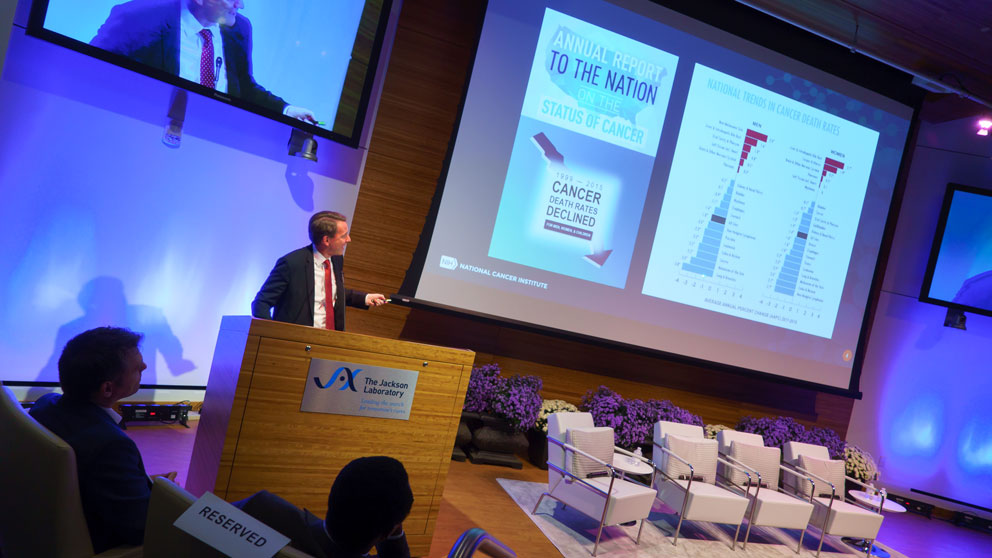
Norman “Ned” Sharpless, M.D., has served as director of the National Cancer Institute (NCI) for about a year now. His tenure has begun during what is arguably the most exciting era of cancer research to date, with great promise for improved treatments. Significant challenges remain, however, and both sides of the equation were on display during his keynote address “Fighting Cancer: Past, Present & Future” at the JAX Healthcare Forum.
On the clinical side, the news is very positive overall and has been for a while. Since 1993, in fact, the mortality rate for most cancers has dropped significantly, driven by behavioral changes such as reduced tobacco use in addition to therapy advancements. At the same time, news headlines over the summer helped to underscore the importance of Dr. Sharpless’s role moving forward. Certain cancers remain intractable, and the recent deaths of singer Aretha Franklin from pancreatic cancer and Senator John McCain from glioblastoma have served as stark reminders that there is still a long way to go.
How do we get there? A key factor is the recognition that, at the molecular level at least, cancer is actually thousands of diseases, not just one. Dr. Sharpless discussed how cancer research has changed as a result, as understanding the characteristics of individual cancers is vital to developing more targeted, less toxic therapies. The benefits of such therapies are many, and the advent of precision therapeutics that attack cancer cells’ weak points while leaving normal cells and tissues relatively unscathed is a huge step forward. He also noted the rise of immunotherapies, a developing field with vast potential.
More targeted therapies also represent a huge burden on some of the existing medical infrastructure, however, including clinical trials. Molecular characterization of tumors means more precision, but it also means smaller patient populations for each new therapy. Dr. Sharpless acknowledged the difficult issue of high drug prices, and the new capabilities increase per-patient accrual costs sharply, further exacerbating the situation. It’s no surprise then that he identified clinical trial reform as one of his and the NCI’s key focus areas moving forward. The traditional model of large patient population, double-blind trials is unwieldy in the current context, so new designs that improve efficiency while maintaining sufficient safety and efficacy evaluations are needed. To this end, the NCI recently launched Molecular Analysis for Therapy Choice (NCI-MATCH), a precision oncology trial experimental protocol based on molecular analysis of patient tumors. It has proven to be very successful from both a logistical and results standpoint, and it is now ongoing at more than 1,100 sites in the U.S.

A related topic is infrastructure investments in big data. On the clinical side, think about a pathologist looking at a slide and taking notes compared with genome sequence and mRNA transcriptome analyses and more. It’s clear why far more cancer data must now be managed than ever before. On the research side, it can be even more of a challenge, as scientists delve into every detail of cancer cell initiation and progression. The NCI can help the cancer community handle the data onslaught, however, and key initiatives include building out cloud resources and a data commons framework, as well as collaborating with industry to integrate EHR and insurance claims data with the NCI’s Surveillance, Epidemiology and End Results (SEER) Program, which has built and maintained patient registries since 1973 and has data covering 34% of the U.S. population.
Another side of precision tumor profiling is to refine or at times even reduce treatments for certain types of cancers. In this scenario, the NCI is needed to play a leading role, as pharmaceutical companies tend not to commission large, expensive trials that lead to reduced use of their products. Dr. Sharpless pointed a recent NCI study, Trial Assigning Individualized Options for Treatment (RX) (or TAILORx), concluded this summer, that indicated that most women with certain breast cancers do not benefit from chemotherapy when the cancer is detected early. The finding has significant quality of life implications for this patient subset, as treatment with hormonal therapies alone carries with it fewer side effects. Nonetheless, changing standard of care practices in the clinic can be a slow, frustrating process, so the NCI is working to disseminate these results and others as quickly as possible.
But what about cancer prevention, the best scenario of all? There are known preventions in the modern era: staying thin, avoiding mutagens (such as tobacco) and getting HPV and hepatitis vaccines. Beyond that, it becomes a very difficult topic, and a lot of money has been spent without results. An example is ASPREE, a trial run by the NIH that investigated whether low-level aspirin can serve to reduce all-cause mortality in a healthy elderly population. Unfortunately, the data showed slightly worse mortality rates for the aspirin takers. Any small-molecule cancer preventative needs to be completely non-toxic, and no successful compounds have been identified to date. Better and earlier detection methods, including new imaging capabilities and liquid biopsies, may be more important for improving outcomes, at least in the short term.
The challenges remain formidable, but so are the tools available to researchers and clinicians and patients as they move forward into the next phase of cancer research and care.
As a result, the next decade will offer more hope for cancer patients than previously possible. Dr. Sharpless even used a word — “cure” — usually absent from cancer care discussions before now, indicating that the NCI is moving forward with optimism as well.